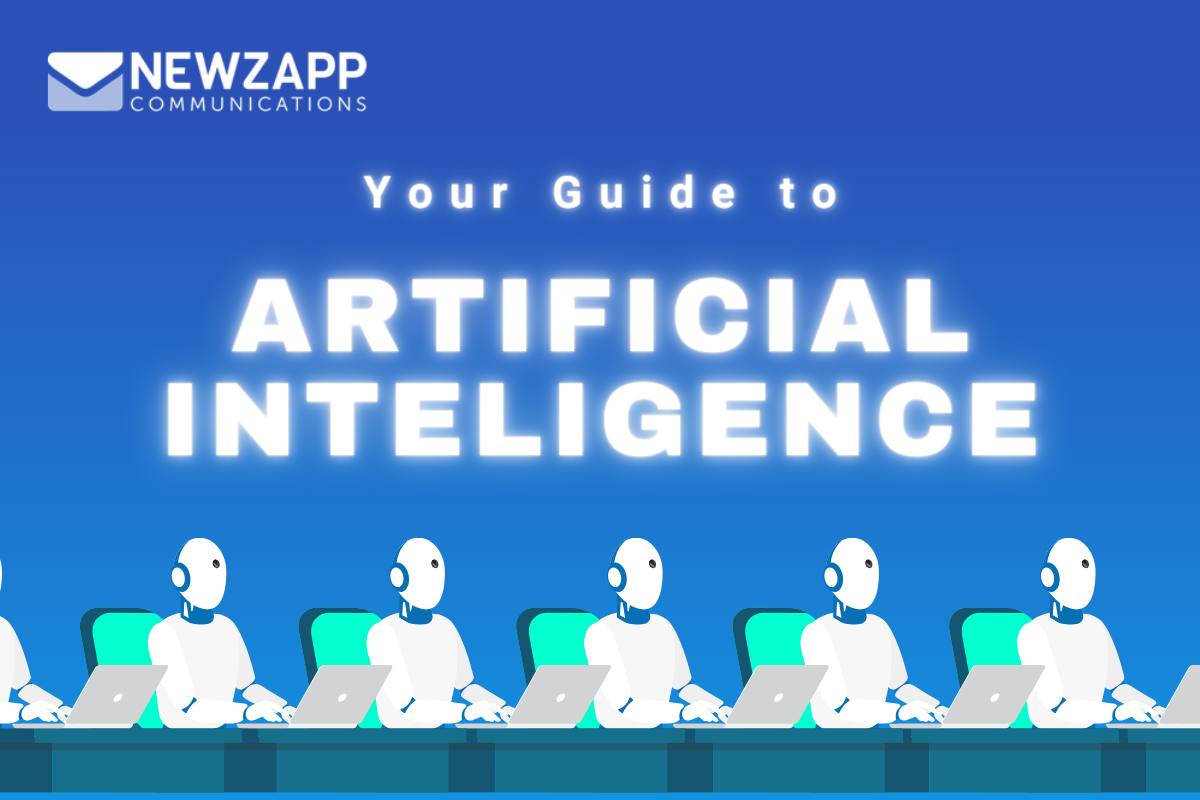Unlocking the Power of AI in Internal Communications: A Comprehensive Guide
Using AI for internal communications, in today’s fast-paced digital landscape, has become increasingly essential for effective engagement and management. At NewZapp, we understand the pivotal role AI plays in streamlining processes, enhancing engagement, and fostering collaboration within dispersed workforces. Join us as we delve into the intricacies of AI and its transformative impact on internal communications strategies.
Navigating the AI for Internal Communications Landscape
Artificial intelligence is revolutionizing the way organizations communicate internally, offering a myriad of tools and solutions to optimize processes and drive productivity. From chatbots and virtual assistants to predictive analytics and sentiment analysis, the possibilities are endless. Embracing AI empowers internal communications teams to deliver targeted messages, personalize content, and measure the effectiveness of their campaigns with unprecedented accuracy.
Key Benefits of AI Integration
Enhanced Personalization
By leveraging AI-powered algorithms, internal communicators can tailor content based on employee preferences, roles, and engagement patterns, ensuring each message resonates with its intended audience.
Improved Efficiency
Automation tools enable streamlined workflows, from content creation and distribution to response management, freeing up valuable time for teams to focus on strategic initiatives.
Data-Driven Insights
AI-driven analytics provide valuable insights into employee sentiment, engagement levels, and content performance, enabling communicators to make data-driven decisions and refine their strategies in real-time.
Leveraging AI for Dispersed Workforces
In an era of remote work and digital connectivity, maintaining effective communication channels with dispersed workforces presents a unique set of challenges. However, AI offers innovative solutions to bridge the gap and foster collaboration across geographical boundaries.
Virtual Assistants and Chatbots
Utilising predictive analytics and behavioral insights, internal communicators can foresee employee requirements, spot trends, and preemptively tackle issues. Whether forecasting forthcoming projects, gauging engagement levels, or recognizing evolving communication preferences, AI empowers organizations to anticipate changes and adjust strategies promptly.
Predictive Analytics and Behavioural Insights
By harnessing the power of predictive analytics and behavioural insights, internal communicators can anticipate employee needs, identify trends, and proactively address potential issues before they arise. Whether it’s predicting upcoming projects, forecasting engagement levels, or identifying emerging communication preferences, AI enables organizations to stay one step ahead and adapt their strategies accordingly.
Overcoming Challenges and Maximizing Opportunities
While the benefits of AI in internal communications are undeniable, organizations must also navigate potential challenges and ethical considerations associated with its implementation. From data privacy concerns to algorithmic biases, it’s essential to approach AI integration with a thoughtful and cautious mindset, prioritizing transparency, fairness, and accountability every step of the way.
Ethical AI for Internal Comms Practices
Ensuring ethical AI practices is paramount to maintaining trust and integrity within the organization. Transparently communicate the usage of AI technologies, ensure the implementation of data privacy and security measures, and conduct regular audits of algorithms to identify biases and inaccuracies
Continuous Learning and Adaptation
As AI technology continues to evolve at a rapid pace, internal communicators must prioritize continuous learning and adaptation to stay abreast of the latest trends and developments. Investing in employee training and professional development programs ensures teams have the necessary skills and expertise to leverage AI effectively and ethically.
Embracing the Future of Internal Communications with AI
As we look towards the future, the role of AI in internal communications will only continue to grow in significance. By embracing innovation, fostering a culture of experimentation, and prioritizing ethical practices, organizations can unlock the full potential of AI to drive engagement, collaboration, and productivity across their workforce.
The future of AI for Internal Comms
So what should we expect from the future of AI? There are two things to keep an eye on and you may be able to guess. Much like in the 1950s Deep AI or AGI will be a massive focus for researchers going forward, and in the future when it is released Artificial General Intelligence (AGI) will cause even more disruption than Chat GPT in 2022. Making it more important that you gain an understanding of this technology.
The other area to focus is Artificial Narrow Intelligence (ANI). ANI or Narrow AI is being implemented into almost everything, from video creation, image generation, content writing, CAD, Website building and more. It feels like new ANI models are coming out almost weekly now.
Will AI take your job?
Addressing the significant concern of whether AI will replace human jobs, the answer is nuanced. Presently, AI tools often depend on human guidance for generating output, which may not always be flawless. Nonetheless, AI possesses remarkable computational abilities and can brainstorm ideas.
Looking ahead, AI is expected to evolve to a stage where it can outperform humans in various tasks autonomously. At this juncture, AI could potentially displace numerous human roles.
While the prospect of automation replacing jobs is disheartening, it doesn’t necessarily entail chaos. In a scenario where AI handles most tasks, individuals could have more time for personal pursuits like spending quality moments with family and exploring passions.
Transitioning to discussions on transformative technologies, consider the shift from horse-drawn carriages to automobiles in the late 19th century. This transition drastically reduced the demand for stables, stable keepers, and horseshoe makers, causing significant job displacement worldwide.
This type of progression has happened throughout the entirety of human history with old industries being taken over by newer and better ones. Every time that happens people always find a way to adapt to the new environment, this is one of our greatest abilities as humans, the ability to adapt to changing environments.
Returning to the main point, in the near term, AI won’t replace your job; instead, it will likely integrate into your role to enhance efficiency. Over time, as AI advances, it will gain the capability to execute tasks autonomously, leading to the potential displacement of jobs. Therefore, it’s crucial to acquire the expertise necessary to remain indispensable in the face of AI advancement.
How to position yourself to help navigate the future?
Research, optimism and effort
Begin by researching AI to understand its implications for your industry. Approach this exploration with an optimistic bias, considering how AI can enhance industry practices. Identify areas for improvement and the skills required to leverage AI effectively. Taking proactive steps to learn and implement these changes is crucial. Neglecting this could leave you vulnerable to being replaced by someone who combines your expertise with AI
How to use AI for Internal Communications
Now that you know more about what AI is, where it came from as well as future implications of such a technology we will now start learning how to use AI.
Let’s begin with the well-known ChatGPT
ChatGPT operates off of a simple Prompt-and-response system. You write a prompt, which can be a question or a task, and then the AI will generate a response based on the context of the prompt and its own learned data.
This sounds super simple, that is because it is. The skill lies in your ability to create an accurate prompt so that the AI can generate the best response/answer to your prompt/question.
The Art of Prompts
Example 1; “Can you write a blog about AI”
ChatGPT will then go away and generate a very generic blog talking about AI. Since you have not given it much context the response generated will lack lustre.
Example 2; “Can you write a blog about how AI will affect those working within internal communication roles”
This prompt is much better than the first as it offers more context about the target audience for the piece as well as a more specific topic.
The amazing thing about AI is that it is capable of making adjustments to previous responses as long as you ask the right prompt.
Example 2a; “Write a paragraph at the end of the blog with compelling call-to-action messages that lead readers to my landing page about [insert landing page details]”
This advanced follow-up prompt surpasses the previous ones by requesting ChatGPT to craft a tailored paragraph, specifically aiming for “compelling call-to-action messages leading readers to my landing page.” While we could have settled with this prompt initially, the initial response from ChatGPT might have lacked specificity and context, necessitating additional input later. By including this additional detail, ChatGPT gains the necessary context to generate a response aligned with our requirements.
Adding that last bit of the prompt gives ChatGPT the context required to generate an accurate response to my wants.
ChatGPT Limitations
Every AI has its limitations ChatGPT is no different
- There is a possibility for misinformation
- It can generate inaccurate information
- ChatGPT 3.5 (Free Version) only has information dating up to 2021
AI is not perfect and still requires human input to generate responses and to ensure the responses are accurate.
This brings up a golden rule of AI, at least for AI as it is now, don’t take AI’s responses as gospel. Always read through the response and ensure that it is accurate.
Other AI
So far we have only been talking about ChatGPT, the skills you learn here with prompt creation will carry over to other similar AI models, Google’s Bard and Microsoft’s Bing (based on ChatGPT).
However, AI is not limited to text-based responses. DALL.E 2, MidJourney and Leonardo AI are capable of generating images based on text input.
Even commonly used platforms like Canva, and selected Adobe products have incorporated AI into their software.
Canva
Canva has become a popular choice for design projects due to its user-friendly interface and extensive template library, catering to a wide range of users. Recently, Canva has expanded its offerings to include an AI image generator and a video generator.
Despite the shift from text to visual content, prompt-based systems remain essential for generating images and videos. However, unlike prompts used for ChatGPT, AI-driven image and video generation rely heavily on descriptive language. The ability to vividly depict scenes through words enhances the accuracy of the generated image or video.

Example 1: “Candle flickering”

Example 2: “Crowded shopping district in London with clothing shops in the background”
Key takeaways and actionable steps
There are hundreds of AI out there and more and more businesses are incorporating AI into their products and operations. While we mainly covered AI which can be used externally or for internal communications there are AI that are purpose-built to help with business operations and more technical roles such as coding.
The first thing you need to do is find out which AI you can use to enhance your work.
Secondly, you need to use those AI software wherever you can to better learn the intricacies of them.
After you’ve gained some experience using AI and have improved your prompt engineering skills, you need to think about how AI can be used to supplement your role. Not take over your role, but to supplement certain aspects of it. For example; maybe there are certain data-crunching aspects of your role where you need to manually create a manager report, can you use AI to automatically generate manager reports every month giving you more time to do other tasks?
After research comes implementation. Have discussions with leadership presenting your findings and offering suggestions of where AI can be implemented to improve your role. Remember AI is a tool that can be used to enhance your craft.
To get you started on your journey to master AI here are some key resources.
AI Resources
How internal communicators can use AI – How ChatGPT Will Revolutionise Internal Communications – NewZapp Communications
Learn how to engineer prompts w/ Google – Prompt Engineering for Generative AI | Machine Learning | Google for Developers
Text generation: Chat GPT – https://chat.openai.com/
Image generation: DALL.E 2 – DALL·E (openai.com)



